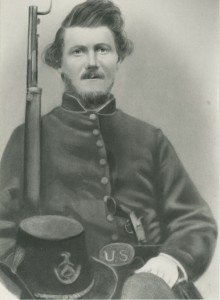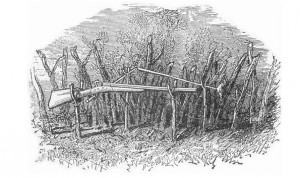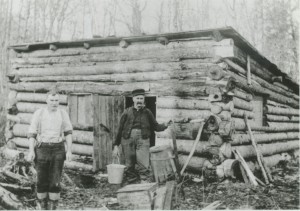by Stewart Allison McFerran
My great-great-grandfather James Gray Brady served in the Michigan Militia supporting Union forces in the Civil War. I have a picture of him and his rifle. I do not possess the firearm in the picture, but I think I know where it is.

After he returned from the Civil War, laws regarding firearms were passed by many different units of government. (There is a twenty page list of gun laws in the book Guns Across America, published in early 2015). The laws concerned many different aspects of the use and ownership of guns.
Laws in Michigan prohibited the firing of guns in towns. One such law was passed in 1887. Concealed-carry gun laws were passed in Michigan in 1887, 1891, and 1895. There were additional state laws passed regarding the sale and carry of firearms in 1901 and 1925. In 1931 a Michigan law prohibited the brandishing of firearms.
The Uniform Firearms Act, model legislation for states to adopt that established new, restrictive rules on carrying firearms in public, was passed in Michigan and other states in the 1920s. The National Conference of Commissioners on Uniform State Laws recommended that states require licenses for concealed weapons in public. The Commission also recommended that licenses be issued only to a “suitable person” with a “proper reason for carrying a firearm.” Gun sellers were to be licensed and not allowed to sell guns to persons convicted of violent crimes, drug addicts, drunkards, and minors.
After the Civil War, many guns used by solders like Grandfather Brady became obsolete and uncared for. In an effort to remove these dangerous weapons from homes, legislation was passed that required individuals to register their guns. Gun owners not wanting to pay to register their guns could turn them in to local authorities.
Traverse City Police Chief Blacken had lots of firearms turned in to his office in 1926. There were many Civil War rifles that “would fire when you least expected,” as reported in the Traverse City Record-Eagle on November 6, 1926. Chief Blacken dumped the guns in Grand Traverse Bay, ensuring the public’s safety from dangerous misfires .
Many of the rifles and handguns Chief Blacken dumped in the Bay and the Boardman River were turned in by those who did not care to register their firearms; Most dated from the Civil War. My great-great grandfather James Gray Brady’s rifle may be among the ancient firearms at the bottom of the Bay.

My great grandfather James Samuel Brady hunted lands in Northern Michigan from his camp “Pokey Huddle”. In a treasured photograph he is pictured with his father-in-law, William Wallace Smith, and Uncle Willy. They are all holding rifles and ready to hunt, no different from Northern Michigan hunters of today .

Laws have changed what, where, and how hunters hunt. Attempting to keep up with new technology, in 1913 the Michigan Legislature passed a law requiring registration of all firearms; in 1927, machine guns with more than sixteen bullets were banned; in 1929, machine guns with silencers were banned; in 1931, gun traps were banned in Michigan.
In 1925The American Bar Association Journal published Legislatures and the Pistol Problem, an article that emphasized that the public was against the possession of guns that could be concealed. The police agreed with this opinion at the time. No doubt, Chief Blacken of Traverse City felt that public safety was enhanced by sending large numbers of pistols to the bottom of the Bay. For the same reason, the person–or persons–who dumped the firearm into a hole at the Dougherty home on Old Mission most likely did so to ensure that the firearm would not hurt anyone.
The most recent efforts to address gun rights in Michigan are Senate Bills 442 and 561 (October 2015). These bills, if passed, would allow individuals to hide pistols as they walk into Michigan schools, dormitories, and sports stadiums.
In District of Columbia v. Heller, 554 U.S. 570 (2008), the Supreme Court ruled in favor of Heller, striking down a District of Columbia prohibition on the possession of usable firearms in the home because the law banned “the quintessential self-defense weapon” in the home. However, the Court also added, “nothing in our opinion should be taken to cast doubt on longstanding prohibitions on the possession of firearms by felons and the mentally ill, or laws forbidding the carrying of firearms in sensitive places such as schools and government buildings.”
One of the founders of the National Rifle Association, Karl T. Frederick, “the best shot in America” who won three Olympic gold shooting medals in 1920 at Antwerp, : “I do not believe in the general promiscuous toting of guns. I think it should be sharply restricted and only under license”. We should all consider the wisdom of the Olympian Frederick as new gun regulations are put in place.

James Gray Brady would be shocked to know that guns have become an issue of national debate. But, now–as during the Civil War he fought–the firearm death toll is high. The rights sought by one side are non-negotiable: a way of life threatened. While governments seek the power to mediate a settlement between citizens with anything other than a heavy hand, we all look on while tens of thousands suffer gunshot wounds, even to the point of maiming worthy government servants like Gabby Giffords of Arizona.
Next time you take a boat ride on Grand Traverse Bay, look down into the water. Who knows?–you might see a cache of ancient firearms somewhere on the bottom where Chief Blacken dumped them. You might even find my great-great grandfather’s rifle.
Among all the solutions to the gun problem listed above, I endorse Chief Blacken’s solution as the best.
Stewart Allison McFerran is a regular contributor to Grand Traverse Journal.
Bibliography:
- Guns Across America, Oxford 2015 Robert J Spitzer
- Gun Fight, Norton 2011, Adam Winkler
- Grand Traverse Journal, August 2015
- Grand Traverse Herald, November 1926
- MLive, October 13, 2015 LANSING, MI — A Michigan Senate panel on Tuesday approved gun bills that would allow concealed carry instead of open carry in schools, moving ahead despite concerns from education officials who fear the proposal will do little to shield students from possible violence.

